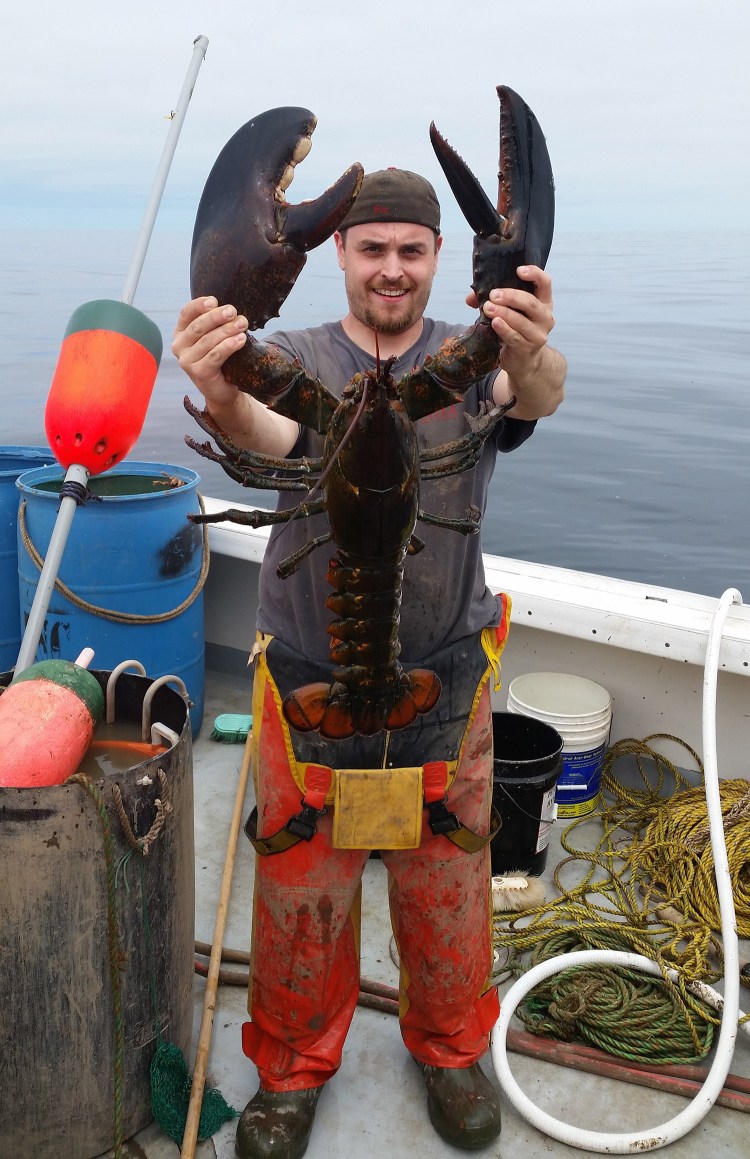Ricky Louis Felice Jr. had never seen such a monster of the deep before, so he posted a photograph of himself holding the 3-foot-long, 20-pound lobster on his Facebook page Monday.
Since then, Felice, a 24-year-old criminal justice major from Cushing, said he has been bombarded with requests for interviews from news media outlets across Maine and New England.
Felice was working as a deckhand on the Big Dipper, a lobster boat based in Friendship, in late May when the crew hauled up a trap with the behemoth cowering inside.
Though the hardshell lobster was caught more than a month ago, Felice said he decided to post its photograph Monday on Facebook after his friends urged him to.
“He was huddled over in the corner (of the trap), all balled up. Lobsters are very territorial and I don’t think he liked the fact that there were five lobsters inside the trap with him,” Felice said Monday evening. “His whole body was inside the trap. He was the biggest lobster I’ve ever seen in my life.”
The three-man crew of the Big Dipper, which is captained by Isaac Lash of Friendship, each posed for a photograph with the big crustacean before tossing it back into the Gulf of Maine.
“He was a monster. Gladly threw him back with hope of catching him again,” Felice wrote on his Facebook page.
According to Lash, the 43-foot Big Dipper had been fishing in late May in waters south of Monhegan Island when the crew pulled up the trap with the lobster inside. Despite its large size, scientists say lobsters have the ability to cram their bodies into tight spaces.
Lash, who has been fishing for more than a decade, thought nothing of the catch because it is not uncommon for him to trap lobsters that exceed the legal limit on a regular basis. Those lobsters never make it to the dining room table in Maine because state law requires that lobsters be no shorter than 3¼ inches or longer than 5 inches.
The measurement is taken from the extreme rear section of the animal’s eye sockets to the end of its carapace or back. The penalty for keeping an undersized or oversized lobster is a fine of up to $500 for each violation.
“I’ve seen lobsters as big or bigger than that one,” Lash said. “It’s neat to see such a big one, but it’s not that rare.”
Lash described the lobster as “pretty fat and healthy and it had really big claws.”
Though Lash said he is no expert, he guesses that the lobster his vessel caught – if it were to be steamed and cooked – could have easily fed three or four people.
According to the Maine Department of Marine Resources, the record for the largest documented lobster goes to one caught off the coast of Nova Scotia in 1977. It weighed 44 pounds, 6 ounces and was estimated to be 100 years old.
Lash, Felice and Lash’s sternman, Levi Poland, estimated that the lobster they caught was 75 years old, but scientists disagree with that assessment.
“I would question it being 75 years old,” Robert Steneck, a University of Maine professor of marine science, said Monday after studying the photograph online. “It’s probably more in the range of 25 to 50 years.”
Steneck’s Web page says he uses manned submersibles and remotely operated underwater vehicles to study lobsters, sea urchins and kelp. Steneck, who works out of the Darling Marine Center in Walpole, is a veteran marine researcher with more than 20 years’ experience.
He believes an important way to understand organisms is to study them in their habitat, which is why he spent several years in submarines exploring the ocean floors off Maine’s coast. He remembers the time that his submersible encountered a giant lobster off Mount Desert Island – it looked to be about 25 pounds – that attacked and nearly became entangled in some of the hull’s equipment.
Steneck said the lobster caught by the crew of the Big Dipper is definitely a male. Females have a much wider tail. Its larger claw – known as the crusher claw – is also a male characteristic.
“It’s a good size, but it is not outrageous,” Steneck said.
Diane Cowan, a senior scientist at The Lobster Conservancy in Friendship, said large lobsters need to be protected because they produce more offspring.
“They are proven survivors, which makes them more important to the gene pool,” she said.
Cowan was less certain about the lobster’s age, adding, “No doubt in my mind this lobster has been around at least a few decades.”
As for its size, Cowan said the lobster caught by the Big Dipper is large, but not giant.
“Giant would be 40 pounds or more,” Cowan said in an email. “No one has seen them (giants) since the 1950s. Too bad.”
Send questions/comments to the editors.




Comments are no longer available on this story